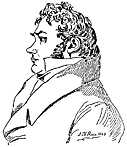


The Swedish chemist, Jons Jacob Berzelius (born 1779, died 1848; sketched at right→) wrote Dalton that the theory of multiple proportions is a mystery without the atomic hypothesis.
By 1812 Berzelius had firmly established the Law of Multiple Proportions by analyzing a large number of examples and became a leading advocate for the atomic hypothesis.
The French chemist Joseph Louis Gay-Lussac (b1778, d1850) by 1809 announced that the ratios of the volumes of reacting gases are small whole numbers. This provided a more satisfactory method for Berzelius to establish the formulas of gases.
In 1811 the Italian Amadeo Avogadro (b1776, d1856) based on a study of Boyle's Law of gases, amplified the Law of Gay-Lussac to suggest that equal volumes of different gases contain the same numbers of particles. He deduced from the densities of Hydrogen and Oxygen that the atomic weight of Oxygen was 15 times that of Hydrogen. The idea required, however, that some particles which he called integral molecules (or diatomic molecules), be composed of several smaller but identical elementary molecules. (Note that vocabulary was not yet well established: What Dalton called atoms
, Avogadro called molecules.
We now use the term molecule
to describe a grouping of atoms.)
Berzelius could not conceive of a way that identical elementary molecules, as required by Avogadro's hypothesis, could unite together.
J.B.A. Dumas also found the idea inconsistent with vapor densities of the Sulfur, Phosphorus, Arsenic, and Mercury with formulas believed correct at that time.
John Dalton had also previously considered and rejected Avogadro's hypothesis. Thus Avogadro's hypothesis was rejected by most chemists.
While Dalton had suggested that atoms combine in simple integer ratios, he did not provide a way to determine which ratio described any particular compound. (E.g., water could be HO or H2O. Dalton thought the simpler ratio, HO, was more likely.) In 1819 Pierre Louis Dulong (b1785, d1838) and Alexis Therese Petit (b1971, d1820) announced that the product of atomic weight and specific heat for an element is approximately constant. This provided a way to select the most likely atomic weight from a series of plausible formulae. (E.g., if water is HO, the atomic weigh of Oxygen would be 8; if water is H2O the Oxygen would weigh 16.)
Eilhard Mitscherlich (b1794, d1863), a student of Berzelius, in 1820 announced that when two substances crystallize in similar forms, they usually have analogous formulas (with the same combining ratios). This provided another method for establishing the most plausible formula.
Berzelius used available information and rules to determine chemical formulas. He derive tables of atomic weights for about 2000 simple and compound substances. Different atomic weights provide a useful property that Berzelius and others used to distinguish newly discovered elements.
Dalton had used a variety of circles with interior markings as symbols for elements (as shown on the previous page). But remembering, writing, and printing the symbols was difficult. Berzelius suggested that the capital initial letter of the Latin name for each element be should be used as its chemical symbol. When several names begin with the same letter, he suggested the next distinctive letter of the name be added in lower case. (E.g, Carbon = C; Calcium = Ca) This symbolism using letters derived from the element's name was rapidly adopted.


| introduction | Greeks | alchemy | Lavoisier | Dalton | ↑ | molecules | spectra | electron | radiation | Bohr | isotopes | synthesis |
| to site menu | Discovery and Naming of Chemical Elements |
chemistry | physics | |||||||||
| created 23 March 2002 latest revision 26 April 2010 |
by D Trapp | |||||||||||